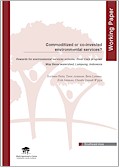| Working Paper Series |
 |
|
| Title | Commoditized or co-invested environmental services? | | Author | Rachman Pasha, Tonni Asmawan, Beria Leimona, Erik Setiawan and Chandra Irawadi Wijaya | | Year | 2012 | | Publisher | World Agroforestry Centre - ICRAF, SEA Regional Office | | City of Publication | Bogor, Indonesia | | Series Number | Working paper nr 148. DOI: 10.5716/WP12051.PDF | | Number of Pages | 27 | | Call Number | WP0160-12 | | Keywords | watershed management, participative approach, river care program, rewards for
environmental services, landscape conservation co-investment |
|
| Abstract: |
The World Agroforestry Centre, through its Rewarding Upland Poor for Environmental
Services (RUPES) project, carried out action research on a rewards for environmental
services scheme that bridges conservation and poverty alleviation objectives: the
development of a River Care program in Way Besai watershed, Lampung province,
Indonesia. The program involved farmers in Air Ringkih sub-watershed as environmental
services providers and the Pembangkit Listrik Tenaga Air (Besai Hydropower Company/PLTA)
under the authority of Perusahaan Listrik Negara Sektor Bandar Lampung (State Electricity
Company, Sector Bandar Lampung/PLN-SBDL) as the environmental services beneficiary. The
community was contracted to reduce the sedimentation rate in Air Ringkih sub-watershed
by 30% in a one-year period. As the reward, PLN-SBDL provided a microhydropower unit
valued at IDR 20 million (± USD 2120). The reduction target was determined through
negotiations between ICRAF and PLN-SBDL, which showed PLN-SBDL’s willingness to pay in
turn for sediment reduction. River Care developed in four stages: 1) scoping; 2) stakeholder
analysis; 3) negotiations; 4) implementation and monitoring.
At the end of the program, the community executed the contract with an 86% activity
success rate. Analysis of sediment concentration showed a 20% decrease by comparison of
the initial baseline slope value of 299.08 to the final value of 239.27 at the end of program.
The agreed 30% reduction target was not achieved. However, PLN-SBDL very much
appreciated the community’s efforts in reducing the sediment concentration in Air Ringkih
River and gave the microhydropower unit as a reward regardless of the results. The
appreciation showed by PLN-SBDL had a big impact on the community’s role in improving
the maintenance of their environment, in particular, their watershed. This was the main
objective of the rewards for environmental services mechanism: the community in the
upper stream area continue to manage their land using soil and water conservation
techniques to maintain natural resources and reduce sedimentation.
The case of River Care showed a shift in the paradigm from ‘commoditized environmental
services’, which is focused on market or environmental services trade, to ‘co-investment in
landscape conservation’, which is focused on co-investment for watershed conservation. In
practice, ‘co-investment’ in such schemes’ implementation promote stakeholders’
participation—both upper and downstream communities, government and private
entities—to take into consideration efficiency and fairness, building stakeholders’ trust,
promoting transparency and collaborating in sustainable watershed management. |
|